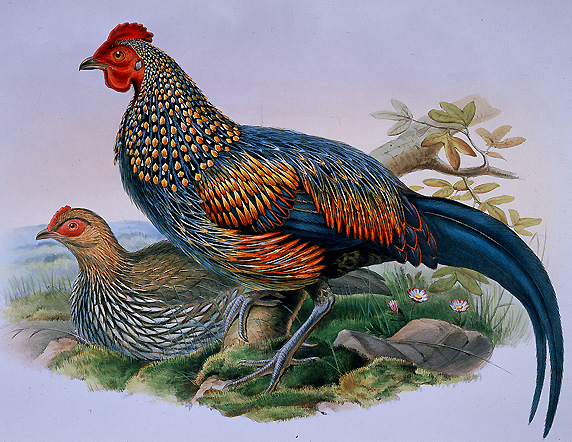 Grey Junglefowl
Grey JunglefowlGallus sonneratii (Temminck)
 Grey Junglefowl
Grey JunglefowlThese birds are distributed throughout Western and southern India, north to Mt. Abu on the west and to the Godavery River on the east (Peters 1934).
In literature, Hume and Marshall in The Game Birds of India Burmah and Ceylon (Calcutta, 1878) remind us that "the best time to shoot the Jungle-Cock is from October to the end of May, as then his hackles are in the best condition." They describe how professional fowlers trapped the cocks during prime plumage and brought them market. However, "except for his feathers or as a specimen, the Grey Jungle-Cock is hardly worth shooting; the best breast is very dry and hard." As a result, the fly dresser of the nineteenth century had a seemingly inexhaustible supply of feathers from a bird that was popular with sportsmen but unpopular with chefs.
Of all the feathers used by the fly dresser, the most recognizable come from the Grey Junglefowl. In respect to plumage color, Delacour (1951) writes that specimens from the northern regions of their range tend to be light in color, while those from the south tend to be dark and brightly colored. Similarly, domestically reared birds tend to be lighter in plumage than those from wild stock. "The curiously bright horny spangles of the neck feathers and wing-coverts," writes Delacour (1951), "are a very special feature of the Grey Cock, but as they are greatly prized for making artificial flies used in trout fishing, these ornaments also have caused the destruction of many birds. They are, however, still numerous in all parts of their range. Their breeding in large numbers for the exploitation of their feathers would be well worth trying."
These enameled neck feathers have been used in almost all types of flies. For example: in the wings of wet flies such as Col. Downman's Fancy, Imbrie, Jungle Alexandra, and Corrie Fly; as cheeks or wings of hairwing flies such as the Scott Special, McGregor and Bucktail Coachman; as cheeks in streamers such as Chief Needabeh, Bumblepuppy and Black Gnat; and finally as sides or cheeks, tails and veilings of salmon flies such as Mar Lodge, Jungle Hornet, Rouge-et-Noir, Jock Scott, and Thunder and Lightening.
If you want to know more about these birds and others related to our fly tying heritage, we suggest you order Rare and Unusual Fly Tying Materials: A Natural History.